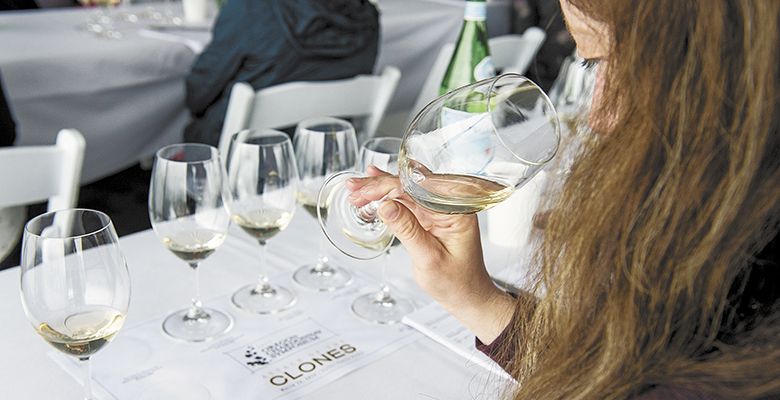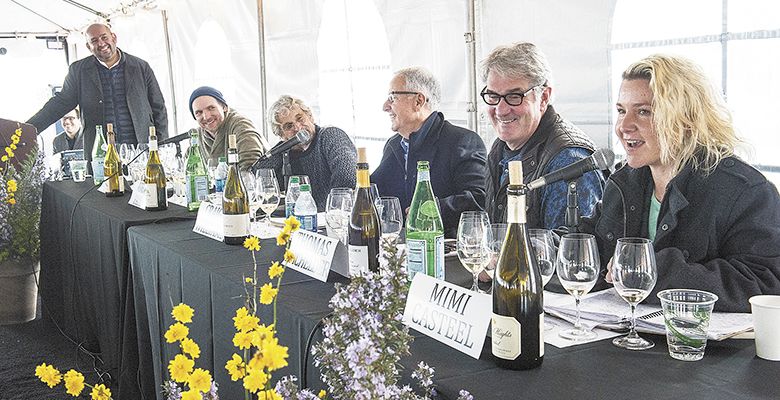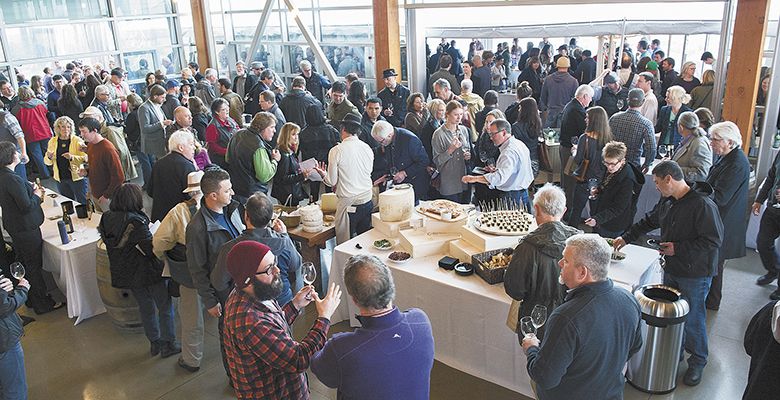End of the Clones
Chardonnay Symposium focuses on site selection
Chardonnay can be a wine that “nudges you to a place of nostalgia or panic.” These words from Bethel Heights’ Mimi Casteel might be the most compelling spoken at the fourth annual Oregon Chardonnay Symposium held March 14. Is this a challenge, goal or a call to action? The message is as much a puzzle as Oregon Chardonnay itself.
Joining Casteel on the speaker panel for the technical tasting were Jason Lett of The Eyrie Vineyards, John Paul of Cameron Winery, Craig Williams of X Novo Vineyards and Thomas Bachelder of Bachelder Wines. Moderating was Rajat Parr of Seven Springs Estate. All speakers illustrated their points with a Chardonnay from their wineries.
Bachelder, who makes wine in Oregon, Burgundy and Niagara, finds Oregon “the most surprising;” while Casteel observed Oregon Chardonnay has had a “confused evolution” and is now at a “turning point.” There were many peripheral conversations at the event contemplating the characteristic qualities of Oregon Chardonnay and how to share them with consumers in a meaningful way.
Oregon Chardonnay has been building to this defining moment. Perhaps, this is why the symposium has experienced exponential increases in attendance. The symposium grew from 75 people four years ago, comfortably accommodated at Red Ridge Farm’s event hall, to a sold-out crowd of more than 200, filling Stoller Family Estate’s tasting room and event tent, too.
With improved clones and winemaking techniques suiting the terroir, Oregon is poised to stake a claim to yet another Burgundian varietal. It is no wonder industry and consumers alike are eager and curious.
Clones were the non-topic of the symposium oddly named “Attack of the Clones.” Parr began with the statement, “I never pay attention to clones.” Midway through the event, he joked about a need for T-shirts reading “End of the Clones.”
And yet, a basic understanding of clones is useful. Paul, in a “John Paul Science Talk,” says clones are “plants from the same ancestor that are identical.” Clones are cuttings, not offspring. Unlike Dolly the Sheep, the first animal cloned from an adult somatic cell using the process of nuclear transfer, cloning grapevines is common and involves a sharp knife and some grafting tape. Selections are “plants from a specific place in the vineyard that are not identical.”
Understanding clones helps the industry appreciate Oregon’s Chardonnay past. In 1966, David Lett experienced some success planting Draper clones, cuttings taken from Draper Ranch in St. Helena, California. In 1970, Dick and Nancy Ponzi planted Selection 108 from UC Davis —the Davis clones were not well suited to Oregon, producing high yields and ripening late. In 1975, David Adelsheim traveled to Burgundy in search of different clones. He found ones that ripened earlier than those planted in Oregon and worked with Oregon State University to make them available to Oregon grapegrowers. Known as the Dijon clones, they are the most widely planted today — 75, 76, 78, 96 — and they did not sink their roots into Oregon soil until 1990, when Rollin Soles planted them at Knudsen Vineyards.
Jason Lett added that we discuss clones because of Oregon’s technical approach and history; next he welcomed everyone to the “end of the clonal era.”
Why? Because it is time to focus on other elements of the Oregon Chardonnay equation. There appeared to be a panel consensus that making wine with a variety of Chardonnay clones produces the best results. Paul explained, “Strength lies in diversity, increasing disease resistance and creating a mélange of complexity, flavor and aroma.” Williams of X Novo Vineyard added, “Great clonal diversity expands the expression of the site.”
Location matters. Bachelder referred to Oregon’s Chardonnay producers as “modern monks.” After the fall of the Roman Empire in Burgundy, religious orders possessed the education and land to not only produce wine, but also record observations regarding the influence of various sites. Some legends claim the monks tasted the rocks and soils as part of their research.
Casteel tied the discussion together.
“Clones are important tools to learn about your site.” She explained how Chardonnay has a broad growing range, but the winemaker wants more than simply yields. “Chardonnay can wear a place beautifully or produce something profoundly uninteresting.”
She warned against selecting Chardonnay sites from the land left over where Pinot Noir would not grow and encouraged growers and winemakers to sacrifice Pinot Noir sites. She eloquently supported her stance explaining, “We have a unique gift to bring to the world. Shooting toward Middle C will weigh us down.”
After the technical tasting and panel discussion, speakers and participants met in the Stoller Family Estate tasting room to sample more than 50 Oregon Chardonnays, reflecting far more than one note.
Jade Helm is the author of Tasting Pour, a blog about wine and food. She is a Certified Specialist in Wine (Society of Wine Educators) and has earned a diploma in wine and spirits from WSET.













